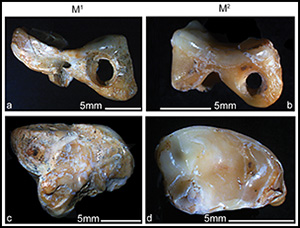Crossref Citations
This article has been cited by the following publications. This list is generated based on data provided by
Crossref.
Falci, Catarina Guzzo
Cuisin, Jacques
Delpuech, André
Van Gijn, Annelou
and
Hofman, Corinne L.
2019.
New Insights into Use-Wear Development in Bodily Ornaments Through the Study of Ethnographic Collections.
Journal of Archaeological Method and Theory,
Vol. 26,
Issue. 2,
p.
755.
Alin, Frînculeasa
Daniel, Garvăn
Monica, Mărgărit
Adrian, Bălășescu
Iulia, Lazăr
Nicoleta, Frînculeasa Mădălina
Andrei, Soficaru Dorian
Mihály, Molnár
and
Migdonia, Georgescu
2020.
Between worlds and elites at the beginning of the Early Bronze Age in the Lower Danube Basin: a pluridisciplinary approach to personal ornaments.
Archaeological and Anthropological Sciences,
Vol. 12,
Issue. 9,
Samei, Siavash
Hovhannisyan, Nelli
and
Gasparyan, Boris
2020.
Economic and symbolic role of animals during the Late Chalcolithic period of Areni-1 Cave, Armenia.
Journal of Archaeological Science: Reports,
Vol. 33,
Issue. ,
p.
102524.
Saratikyan, Ani
2021.
ՈՒՇԱԳՐԱՎ ԹԱՂՈՒՄ ԲՈՎԵՐ ԴԱՄԲԱՐԱՆԱԴԱՇՏՈՒՄ.
Herald of Social Sciences,
p.
255.
Herrscher, Estelle
Poulmarc’h, Modwene
Palumbi, Giulio
Paz, Sarit
Rova, Elena
Gogochuri, Giorgi
Longford, Catherine
Jalabadze, Mindia
Bitadze, Lia
Vanishvili, Nikoloz
Le Mort, Françoise
Chataigner, Christine
Badalyan, Ruben
and
André, Guy
2021.
Dietary practices, cultural and social identity in the Early Bronze Age southern Caucasus.
Paléorient,
p.
151.
Herrscher, Estelle
Poulmarc’h, Modwene
Bitadze, Liana
Vanishvili, Nikoloz
and
André, Guy
2021.
On salt, copper and gold.
p.
325.
Joannin, S.
Capit, A.
Ollivier, V.
Bellier, O.
Brossier, B.
Mourier, B.
Tozalakian, P.
Colombié, C.
Yevadian, M.
Karakhanyan, A.
Gasparyan, B.
Malinsky-Buller, A.
Chataigner, C.
and
Perello, B.
2022.
First pollen record from the Late Holocene forest environment in the Lesser Caucasus.
Review of Palaeobotany and Palynology,
Vol. 304,
Issue. ,
p.
104713.
YELÖZER, Sera
2022.
KİŞİSEL SÜS EŞYALARI KİMLİKLER HAKKINDA NE SÖYLER? METODOLOJİK YAKLAŞIMLAR VE ANADOLU VE LEVANT’TAN ARKEOLOJİK ÖRNEKLER.
Anadolu (Anatolia),



